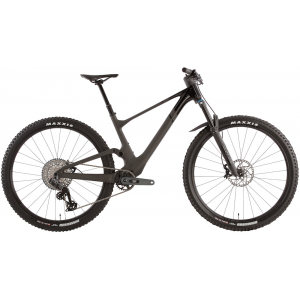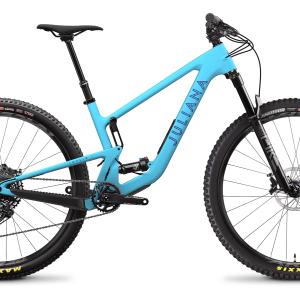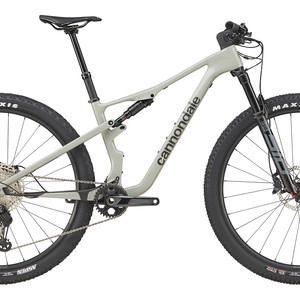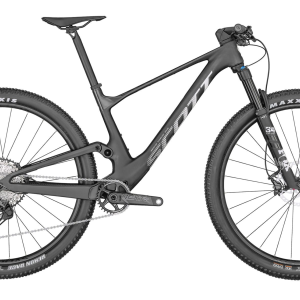2022 Scott Spark 910 Bike
(discontinued)
| Where To Buy | |||
|---|---|---|---|
Free shipping on orders over $50 (continental U.S. only).
International shipping available. Some exclusions apply. |
Free shipping on orders over $50 (continental U.S. only).
International shipping available. Some exclusions apply. $3,280.50
|
||
Free shipping on orders over $50 (continental U.S. only).
International shipping available. Some exclusions apply. |
|||

Jaded by years of analyzing mountain bikes claiming to reinvent the wheel, it’s not often we (Vital editors) find ourselves jaw dropped over a new bike. But when Scott launched their reimagined Spark last year, we could not stop admiring its futuristic design and next-level integration. And before you rush to the comments, we know the design mirrors countless similarities to frames from Scott-owned Bold Cycles. We daydream about their bikes, too. What makes the new Spark so exciting is Scott’s willingness to divert from their long-standing, World Cup dominating design and commit to such a bold new design (we couldn’t resist). Offered in two models built around the same frame, the Spark 910 is the longer travel option with slightly slacker geometry and trail-focused components. Claimed to be the perfect mountain bike, we were most excited to toss a leg over the Spark during our Short Travel Test Session to understand the nuances of this intriguing bike.
Strengths | Weaknesses |
|
|
Highlights
- Scott HMF carbon frame
- 29-inch wheels
- 120mm (4.7-inches) rear travel // 130mm (5.1-inches) fork travel
- Integrated single-pivot suspension system
- Three-position, TwinLoc lever-actuated suspension lockout (fork and shock)
- Syncros cable integration system
- 65.8-degree head tube angle (adjustable via modular headset cups)
- 76.4-degree seat tube angle
- 437mm chainstay
- FOX 34 Performance Elite fork, FIT 4 damper
- Proprietary FOX Nude 5T EVOL shock
- FOX Transfer Performance Elite dropper post, 150mm (size large)
- Shimano XT 12-speed drivetrain
- Shimano XT 2-piston brakes with 180mm rotors front and rear
- Syncros Silverton 2.0 wheels
- 29x2.4-inch Schwalbe Wicked Will, Super Race casing, Addix soft front tire
- 29x2.4-inch Schwalbe Wicked Will, Super Race casing, Addix speed rear tire
- 12x148 rear spacing with 12mm through axle
- UDH derailleur hanger
- Removable rear axle lever with tools
- Measured weight (size large, no pedals): 27.4-pounds (13.7kg)
- MSRP: $6,299 USD (as tested)

Spark Overview
Scott offers the Spark in two versions built around the same carbon frame: the Spark RC and Spark 900. We tested the longer travel Spark 910, which features 120mm of rear-wheel travel paired with a 130mm fork. Easily one of the most head-turning bikes of recent times, the Spark features an integrated suspension system that completely conceals the rear shock inside the frame. The design uses a link-driven single pivot with a flex pivot in the seat stay, creating a laterally stiff and lightweight frame that fosters efficiency and power transfer when standing or sitting in the saddle.

The integrated design also protects the rear shock from debris and places it low and centered in the frame, improving stability and handling. Removing or adjusting the shock is achieved via a removable plastic cover on the underside of the downtube. Setting sag is done with a sag indicator sticker on the seat tube pivot; however, you will likely need a second set of eyes to check where you line up on the sticker. A removable plug on the side of the seat tube also exposes the shock o-ring and acts as a second option to check sag.




Once you’ve finished dissecting the shock-less frame design, you’ll likely shift your attention to the Spark’s cockpit. All cables are run internally and enter through the Syncros headset. Plastic covers around the stem and special headset spacers guide cables through the headset to create a clean, simple cockpit. The Syncros headset also pulls double duty, acting as a geometry adjustment by rotating the headset cups 180 degrees. On top of the stem, Scott provides a build-in Garmin mount to top off the integrated cockpit.


The Spark 910 also features Scott’s proprietary TwinLoc suspension system. TwinLoc is a lever-actuated cable lockout that simultaneously adjusts the fork and shock to offer three ride modes: descend (open), traction control, and lockout. The Spark uses a custom FOX Nude 5T EVOL shock with two positive air chambers that are opened and closed depending on the TwinLoc position. In the descend mode, both chambers are open, and full travel can be achieved. In lockout mode, both chambers are closed, and the suspension is almost inactive, except for a big hit blow-off to prevent suspension damage. Traction control mode splits the difference and closes off one chamber, reducing the shock’s air volume and travel. Scott says that the shortened travel and firmer platform in traction mode change the bike’s effective geometry by shifting a rider’s weight higher in the travel and more forward. The TwinLoc lever features three levers to control the dropper post and suspension lockout.

Final frame details include two water mounts inside the front triangle and a removable Syncros axle lever equipped with a 6mm hex key and T30 and T25 Torx hex key.
Geometry
We tested a large Spark 910, which features a 470mm reach, 437.5mm chainstays, a 65.8-degree head tube angle, and a 76.4-degree seat tube angle. We only rode the Spark in the stock, steeper head tube angle as we did not find a need or want to make the bike slacker for our trails. But for riders with steep, technical trails, you can slacken the head tube angle to 65.2-degrees by rotating the Syncros headset cups 180-degrees. Adjusting the headset cups will only affect the head tube angle, unlike many bikes where the seat tube and bottom bracket height are also affected.

Spark 910 Build Kit
Scott offers 16 Spark models to choose from with both carbon and aluminum frame options. The Spark 910 is the cheapest carbon frame build and retails for $6,299 USD, featuring a blend of components that balance weight, climbing efficiency, and descending ability. Highlights include a FOX 34 Float Performance Elite fork with a FIT 4 damper, a proprietary FOX Nude 5T EVOL shock, a Shimano XT 12-speed drivetrain, Shimano XT 2-piston brakes, a FOX Transfer Performance Elite dropper, Syncros Silverton 2.0 wheels and 2.4-inch Schwalbe Wicked Will tires front and rear in their light, Super Race casing.




Compared to Alchemy’s Arktos 120 and YT’s Izzo, the Spark 910 was the only bike with a 130mm FOX 34 fork using FOX’s simpler FIT 4 damper instead of their highly adjustable Grip 2 damper. For stopping power, even though the Spark 910 uses the same 2-piston XT brakes as the Ibis Exie, the use of 180mm rotors front and rear noticeably improved stopping power over the Exie’s undersized rotors. The most confusing component spec on the Spark 910 was the 150mm Transfer dropper post and the 760mm wide Syncros Fraser 1.5 handlebar. We will dive into both components below.
Rider Setup
During our two-week testing period, conditions ranged from loose over hardpack to wet and tacky topsoil. Each tester began with Scott’s recommended 25% sag and then made adjustments to match their preferences and trail conditions. Setting sag did require a second set of eyes if using the sag indicator sticker on the seat tube pivot. We opted to use the window cut out in the frame to check where our o-ring resided. The downside of this method was weaseling our fingers through the hole to reset the o-ring. But patience is a virtue, and luckily, we only had to set sag once per tester.
Greg Montgomery | Jason Schroeder | John Palumbo |
|
|
|
On The Trail
Our Short Travel Test Sessions was conducted throughout the foothills of Boise, Idaho. The trails immediately outside downtown Boise feature flowing single track with high average speeds and occasional rock gardens. An aggressive, heavy bike with slack geometry is often too much. Instead, mid-weight bikes equipped to attack punchy climbs and carry speed on undulating terrain provide the best trail experience.

Descending Performance
While the in-frame shock is aesthetically striking, the design also fostered the most prominent character trait of the Spark: responsiveness. With the shock positioned low in the bike and the frame divided into just two pieces joined by robust pivots, the Spark was the stiffest bike in the test. It was also the quietest, thanks to the snug cable integration through the headset.

On the trail, the Spark was an incredibly light, agile, and nimble bike that demanded precise riding. Despite weighing 27.4-pounds, it accelerated with ease and provided a firm platform that we could press against to squeeze speed out of the smallest trail features. We were also pleasantly surprised to find that clicking the TwinLoc system into Traction Mode on flat traverses helped increase rolling speed without diminishing traction.

The downside to such a responsive frame was the energy required to keep the Spark settled through rough sections without deflecting offline. We ended up running a tad more sag to help keep our weight sat into the bike, improving control through rock gardens. We also adjusted our mentality going into demanding sections, knowing it would take more focus to hold onto the reigns. For this reason, the Spark maintained an aggressive cross-country bike feel, not because it only had 120mm of travel. Despite lacking some composure, the Spark made up for lost time in rowdy sections by carrying great speed on smooth, flat terrain.
Climbing Performance
Even though the Spark 910 shares the same frame as its cross-country sibling, we were not immediately convinced it would be a strong performer on climbs. The main reason for this hesitation was our body position pedaling. Unlike the Alchemy Arktos 120 or Ibis Exie that placed us forward and ready to attack climbs, the Spark positioned us comfortably upright. After all our testers spent time aboard the Spark, the consensus was that putting down power was an effortless endeavor when needed; however, the relaxed body positioning promoted a less aggressive approach ideal for adventurous rides and settling into long climbs.

When we felt like getting on the gas and laying down some watts, the Spark relied heavily on the TwinLoc system to maintain speed and transfer power into forward momentum. Like the YT IZZO, the Spark’s rear suspension design remained very active when open. While this made for a nice ride over rough terrain with endless grip, the Spark simply sucked too much speed out of our smooth, loose-over-hardpack trails. Once we locked out the suspension, the Spark’s climbing abilities were transformed, and hammering up climbs was enjoyable. The suspension still provided a few millimeters of cushion when locked out, which never seemed to diminish pedaling efficiency but improved comfort after a few hours in the saddle. Traction mode was most impactful on undulating terrain where calm climbs were broken up by short descents or technical sections. In traction mode, the suspension was more locked out than not, keeping rolling speeds high while offering enough suppleness to maintain control and traction when needed.
Some riders might find it concerning that a 120mm travel bike relies on suspension lockouts to perform well climbing. Your fears are valid, but once we became accustomed to the strong suits of each TwinLoc mode, we grew to enjoy the ability to quickly toggle between modes to find the best suspension package for a given trail.
Build Kit
The Spark 910 comes equipped with components that perform well when climbing and descending, giving riders the option to easily alter the intended use of the bike with minimal component adjustments. During testing, multiple hypothetic scenarios about component changes that would benefit the bike in either direction were discussed. For example, how much better would the Spark climb with light, carbon wheels? Or, how would descending confidence be improved with a longer dropper post, taller and wider handlebars, and more aggressive tires? We are only going to focus on how the Spark 910 comes stock, but it’s something to keep in mind as riders could easily have two wheelsets with different tires mounted and end up with two bikes in one.
Favorite Components: Schwalbe Wicked Will Tires, FOX Performance Elite Suspension
Looking at components that made the Spark 910 such a well-rounded performer, Schwalbe’s Wicked Will tires were fast rolling with just enough grip to maintain control on descents. They weren’t the lightest tires in the test, but the sidewall support was more substantial than the Maxxis EXO casing used on the other bikes.


The performance of FOX’s 34 Performance Elite fork and Nude 5T rear shock was better than anticipated. Unsure of how FOX’s simpler FIT 4 damper and smallest volume rear shock would handle some moderate abuse, we were surprised by the support both provided. Even though adjustments were limited, we found a setup that allowed us to push the limits of the Spark with great initial stroke suppleness and bottom-out control.
Least Favorite Components: Syncros Cable Integration Headset, Syncros Fraser Handlebar, TwinLoc Lever
Like the YT IZZO, the Spark 910 came with a 150mm dropper post that limited our ability to shift our weight rearward, lowering our confidence on descents. Compounding this problem was the Syncros cable integration system that did not allow us to raise the stem via headset spacers. We still aren’t sold on the long-term durability of the integrated design and were disappointed that we couldn’t easily finetune our cockpit setup. Not helping the situation further was the 760mm wide Syncros Fraser handlebar. Besides being much narrower than we prefer, the 8mm of rise felt too low on a capable bike like the Spark.


Given how reliant the Spark was on Scott’s TwinLoc system, we were disappointed by the quality and design of the lever. With three levers bunched close together, the design felt congested, making it challenging to identify which lever was engaged. On countless occasions, we reached to lockout the suspension and instead dropped our seat post. Using a single bar clamp to mount the unit to the handlebar also allowed the levers to flex when being pushed, making them feel cheap and flimsy.
Vital Test Sessions Take Away
Out of the bikes included in our Short Travel test Sessions, the Spark 910 achieved the best balance of climbing and descending performance, giving riders the option to adjust components as they see fit to best match their riding style. The integrated shock design serves as some excellent eye candy and backs up its looks on the trail, providing a supportive, agile and responsive ride that makes any trail come to life. Maintaining speed is effortless, and generating speed comes naturally. The stiff frame does come at the cost of composure in rough sections, requiring additional focus and precision to stay online. Once charging back uphill, the Spark relies heavily on Scott’s TwinLoc suspension system to maintain efficiency. However, having three suspension packages at your fingertips allows for the best setup to be chosen for a given trail. While it’s not our first choice to convert into a cross-country race bike (that’s what the Spark RC is for), we see ourselves reaching for the Spark 910 for big adventures and long days in the saddle.
For information on the Spark 910, please visit www.scott-sports.com
Specifications
Length: 50mm (SM), 60mm (MD/LG), 70mm (XL)
Length: 170mm (SM), 175mm (MD/LG/XL)
Drop: 125mm (SM/MD), 150mm (LG/XL)
• Single Pivot/Flex Stays rear suspension design
• Scott TwinLoc 2 system provides three suspension modes (Lockout, Traction Control, Descend) for shock and fork via handlebar-mounted remote
• Rear travel by mode: Lockout 0mm; Traction Control 80mm; Descend 120mm
• Head angle adjustable (+/- 6°) by rotation of headset cups
• Internal cable routing, with rear cables/hose routed through stem/headset
• Integrated sag meter at rocker link pivot
• Port in non-drive-side seat tube to view rear travel o-ring on shock
• SRAM UDH (Universal Derailleur Hanger)
• Includes Syncros rear axle; removable lever with 6mm allen, T30, and T25 tools
Scott Introduces the All-New SPARK RC and SPARK 900 (press release)
| Where To Buy | |||
|---|---|---|---|
Free shipping on orders over $50 (continental U.S. only).
International shipping available. Some exclusions apply. |
Free shipping on orders over $50 (continental U.S. only).
International shipping available. Some exclusions apply. $3,280.50
|
||
Free shipping on orders over $50 (continental U.S. only).
International shipping available. Some exclusions apply. |
|||
































0 comments
Post a reply to: Vital Test Sessions - Scott Spark 910